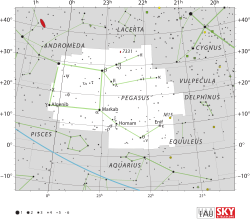2 Pegasi
| 2 Pegasi | |
 | |
| Observationsdata Epok: J2000.0 | |
|---|---|
| Stjärnbild | Pegasus |
| Rektascension | 21t 29m 56,89545s[1] |
| Deklination | +23° 38′ 19,8170″[2] |
| Skenbar magnitud () | +4,52 (V)[3], +4,56 - ? (V)[4] |
| Stjärntyp | |
| Spektraltyp | M1+ III[5] |
| U–B | +1,93[6] |
| B–V | +1,618 ± 0,008[7] |
| Variabeltyp | Misstänkt variabel[4] |
| Astrometri | |
| Radialhastighet () | -18,92 ± 0,12[8] km/s |
| Egenrörelse (µ) | RA: 24,74 ± 0,17[1] mas/år Dek.: 3,63 ± 0,15[1] mas/år |
| Parallax () | 8,28 ± 0,18[1] |
| Avstånd | 394 ± 9 lå (121 ± 3 pc) |
| Absolut magnitud () | -0,89[3] |
| Detaljer | |
| Radie | 55[9] R☉ |
| Luminositet | 653[9] L☉ |
| Temperatur | 3 919[9] K |
| Andra beteckningar | |
| 2MASS J21295689+2338199[10], HD 204724[10], HIP 106140[10], HR 8225[10], IRAS 21276+2325[10], SAO 89752[10], GSC 02188-02203[10], ADS 15027 A[10], BD+23 4325[10], CCDM J21299+2338A[10], FK5 1565[10], GC 30109[10], GCRV 13515[10], HIC 106140[10], IRC +20512[10], JP11 3355[10], N30 4744[10], NSV 25624[10], PLX 5180[10], PLX 5180.00[10], PPM 113087[10], RAFGL 2772[10], SRS 31565[10], TD1 28162[10], TYC 2188-2203-1[10], UBV 18520[10], WDS J21299+2338A[10], YZ 23 8252[10], DO 20521[10], WEB 19233[10], Gaia DR2 1797346167296809600[10], 2 Peg, Gaia DR3 1797346167298274304[10], IDS 21254+2312 A[10], TIC 418607034[10], AG+23 2197[10] och UBV M 25750[10][11] | |
2 Pegasi, som är stjärnans Flamsteed-beteckning, är en ensam stjärna[12] belägen i den östra delen av stjärnbilden Pegasus. Den har en skenbar magnitud på ca 4,52[3] och är svagt synlig för blotta ögat där ljusföroreningar ej förekommer. Baserat på parallaxmätning inom Hipparcosuppdraget på ca 8,3[1] mas, beräknas den befinna sig på ett avstånd på ca 394 ljusår (ca 121 parsek) från solen. Den rör sig närmare solen med en heliocentrisk radialhastighet av ca -19 km/s.[8]
Egenskaper
Primärstjärnan 2 Pegasi A är en röd till orange jättestjärna av spektralklass M1+ III,[5] som förbrukat förrådet av väte i dess kärna, befinner sig på asymptotiska jättegrenen[13] och utvecklas bort från huvudserien. Den har en radie som är ca 55[9] solradier och utsänder ca 653[9] gånger mera energi än solen från dess fotosfär vid en effektiv temperatur på ca 3 900 K.[11] Stjärnans vinkeldiametern mätt genom interferometri, efter korrigering för randfördunkling, är 4,52 ± 0,05 mas,[14] som på det beräknade avståndet motsvarar en fysisk radie av ca 59 gånger solens radie.[15]
2 Pegasi är en misstänkt variabel,[4] som har visuell magnitud +4,56 och varierar utan någon fastställd amplitud eller periodicitet.[4] Den har en visuell följeslagare, betecknad 2 Pegasi B, av magnitud 12,7 vid en vinkelseparation av 30,4 bågsekunder.[16]
Se även
Referenser
- Den här artikeln är helt eller delvis baserad på material från engelskspråkiga Wikipedia, 2 Pegasi, 23 juni 2020.
Noter
- ^ [a b c d e] Van Leeuwen, F. (2007). "Validation of the new Hipparcos reduction". Astronomy and Astrophysics. 474 (2): 653. arXiv:0708.1752. Bibcode:2007A&A...474..653V. doi:10.1051/0004-6361:20078357. Vizier catalog entry
- ^ ”Basic data: V* 2 Peg – Star” (på engelska). Centre de Données astronomiques de Strasbourg. http://simbad.u-strasbg.fr/simbad/sim-basic?Ident=2+Peg&submit=SIMBAD+search. Läst 5 november 2019.
- ^ [a b c] Anderson, E.; Francis, Ch. (2012). "XHIP: An extended hipparcos compilation". Astronomy Letters. 38 (5): 331. arXiv:1108.4971. Bibcode:2012AstL...38..331A. doi:10.1134/S1063773712050015. Vizier catalog entry
- ^ [a b c d] ”NSV 25624” (på engelska). The International Variable Star Index. AAVSO – American Association of Variable Star Observers. https://www.aavso.org/vsx/index.php?view=detail.top&oid=64059. Läst 5 november 2019.
- ^ [a b] Hoffleit, D.; Warren, W. H. (1995). "VizieR Online Data Catalog: Bright Star Catalogue, 5th Revised Ed. (Hoffleit+, 1991)". VizieR On-line Data Catalog: V/50. Originally Published in: 1964BS....C......0H. 5050. Bibcode:1995yCat.5050....0H.
- ^ Mallama, A. (2014). "Sloan Magnitudes for the Brightest Stars". The Journal of the American Association of Variable Star Observers. 42: 443. Bibcode:2014JAVSO..42..443M.Vizier catalog entry
- ^ van Leeuwen (2007). ”Hipparcos, the New Reduction” (på engelska). http://vizier.u-strasbg.fr/viz-bin/VizieR-5?-out.add=.&-source=I/311/hip2&HIP=106140. Läst 5 november 2019.
- ^ [a b] Famaey, B.; Pourbaix, D.; Frankowski, A.; Van Eck, S.; Mayor, M.; Udry, S.; Jorissen, A. (2009). "Spectroscopic binaries among Hipparcos M giants". Astronomy and Astrophysics. 498 (2): 627. arXiv:0901.0934. Bibcode:2009A&A...498..627F. doi:10.1051/0004-6361/200810698.
- ^ [a b c d e] Brown, A. G. A.; et al. (Gaia collaboration) (August 2018). "Gaia Data Release 2: Summary of the contents and survey properties". Astronomy & Astrophysics. 616. A1. arXiv:1804.09365. Bibcode:2018A&A...616A...1G. doi:10.1051/0004-6361/201833051. Gaia DR2 record for this source at VizieR.
- ^ [a b c d e f g h i j k l m n o p q r s t u v w x y z aa ab ac ad ae af ag ah ai aj] SIMBAD Astronomical Database.[källa från Wikidata]
- ^ [a b] 2 Peg". SIMBAD. Centre de données astronomiques de Strasbourg. Hämtad 2019-11-05.
- ^ Eggleton, P. P.; Tokovinin, A. A. (September 2008). "A catalogue of multiplicity among bright stellar systems". Monthly Notices of the Royal Astronomical Society. 389 (2): 869–879. arXiv:0806.2878. Bibcode:2008MNRAS.389..869E. doi:10.1111/j.1365-2966.2008.13596.x.
- ^ Eggen, O. J. (1992), "Asymptotic giant branch stars near the sun", The Astronomical Journal, 104: 275, Bibcode:1992AJ....104..275E, doi:10.1086/116239.
- ^ Richichi, A.; Percheron, I.; Khristoforova, M. (February 2005), "CHARM2: An updated Catalog of High Angular Resolution Measurements", Astronomy and Astrophysics, 431: 773–777, Bibcode:2005A&A...431..773R, doi:10.1051/0004-6361:20042039
- ^ Lang, Kenneth R. (2006), Astrophysical formulae, Astronomy and astrophysics library, 1 (3rd ed.), Birkhäuser, ISBN 3-540-29692-1. The radius (R*) is given by::
- ^ Mason, Brian D.; Wycoff, Gary L.; Hartkopf, William I.; Douglass, Geoffrey G.; Worley, Charles E. (2001). "The 2001 US Naval Observatory Double Star CD-ROM. I. The Washington Double Star Catalog". The Astronomical Journal. 122 (6): 3466. Bibcode:2001AJ....122.3466M. doi:10.1086/323920. Vizier catalog entry
Externa länkar
- https://www.universeguide.com/star/106140/2pegasi.














